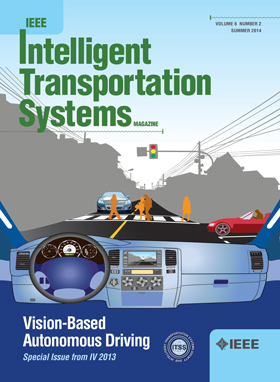交通监控中关键节点识别的双向时间卷积图注意网络
IF 8.4
1区 工程技术
Q1 ENGINEERING, CIVIL
IEEE Transactions on Intelligent Transportation Systems
Pub Date : 2025-04-15
DOI:10.1109/TITS.2025.3555540
引用次数: 0
摘要
在智能交通系统中,关键节点的有效识别对于优化探测器部署和加强交通监控至关重要。然而,现有的方法往往难以适应动态流量变化,从而导致覆盖率达不到最佳水平,并增加了部署成本。我们提出了双向时间卷积图注意网络(BTC-GATs)来解决这些限制。该框架集成了双向注意机制来捕获上下游依赖关系,时间卷积网络用于多尺度特征提取,图形注意网络用于空间信息聚合。BTC-GATs结合了自适应时间建模来捕捉非线性交通动态,基于梯度的变异分析来量化节点影响,以及融合关注系数和拓扑属性的排序机制来进一步增强鲁棒性和互操作性。此外,还进行了关键节点覆盖研究,以检验精度和部署效率之间的权衡。在加州公路PeMS04数据集上进行的大量实验表明,BTC-GATs在关键节点识别方面优于基准方法,具有更高的准确性和稳定性。进一步的分析证实了其在不同交通条件和初始化设置下的稳健性,突出了其作为智能交通监控的可扩展、自适应和经济高效解决方案的潜力。通过促进有效的传感器安置,BTC-GATs有助于改善大规模交通网络的数据收集和拥堵管理。本文章由计算机程序翻译,如有差异,请以英文原文为准。
Bidirectional Temporal Convolutional Graph Attention Networks for Key Node Identification in Traffic Monitoring
Efficient identification of key nodes is crucial to optimizing detector deployment and enhancing traffic monitoring in intelligent transportation systems. However, existing approaches often struggle to adapt to dynamic traffic variations, leading to suboptimal coverage and increased deployment costs. We propose bidirectional temporal convolutional graph attention networks (BTC-GATs) to address these limitations. This novel framework integrates bidirectional attention mechanisms to capture upstream and downstream dependencies, temporal convolutional networks for multiscale feature extraction, and graph attention networks for spatial information aggregation. BTC-GATs incorporates adaptive temporal modeling to capture nonlinear traffic dynamics, gradient-based variation analysis to quantify node influence, and a ranking mechanism that fuses attention coefficients with topological attributes to further enhance robustness and interoperability. In addition, a key node coverage study is conducted to examine the trade-off between accuracy and deployment efficiency. Extensive experiments on the California Highway PeMS04 dataset demonstrate that BTC-GATs outperforms benchmark methods in key node identification, offering superior accuracy and stability. Further analysis confirms its robustness under varying traffic conditions and initialization settings, highlighting its potential as a scalable, adaptive, and cost-effective solution for intelligent traffic monitoring. By facilitating efficient sensor placement, BTC-GATs contributes to improved data collection and congestion management in large-scale transportation networks.
求助全文
通过发布文献求助,成功后即可免费获取论文全文。
去求助
来源期刊

IEEE Transactions on Intelligent Transportation Systems
工程技术-工程:电子与电气
CiteScore
14.80
自引率
12.90%
发文量
1872
审稿时长
7.5 months
期刊介绍:
The theoretical, experimental and operational aspects of electrical and electronics engineering and information technologies as applied to Intelligent Transportation Systems (ITS). Intelligent Transportation Systems are defined as those systems utilizing synergistic technologies and systems engineering concepts to develop and improve transportation systems of all kinds. The scope of this interdisciplinary activity includes the promotion, consolidation and coordination of ITS technical activities among IEEE entities, and providing a focus for cooperative activities, both internally and externally.
 求助内容:
求助内容: 应助结果提醒方式:
应助结果提醒方式:


